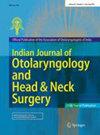Study of metronomic chemotherapy in cancer patients at a tertiary care centre in South India
IF 0.4
Q3 Medicine
Indian Journal of Otolaryngology and Head and Neck Surgery
Pub Date : 2020-12-15
DOI:10.18231/2581-5229.2018.0012
引用次数: 0
Abstract
The past century has witnessed a vast progress in the field of cancer chemotherapy. Angiogenesis is the foundation of cancer existence. Metronomic chemotherapy by definition is the administration of low dose chemotherapy at regular intervals with no long-standing drug free intervals with the aim to achieve continual blood levels of the chemotherapeutic drug, without the severe toxicity profile or the long-standing drug free breaks as seen in maximum tolerated dose (MTD). We conducted a study with the aim to see the role of metronomic chemotherapy in head and cancers at a teritiary care of south India. Materials and Method: We did a retrospective analysis of patients diagnosed with cancer of the head and neck who received metronomic chemotherapy in a tertiary cancer care centre for one year. A total of 46 patients were included in the study. Patients who were at least 18 years old and who had received metronomic chemotherapy for cancer were included in the study. The subjective response was assessed based upon the patients symptoms and clinical examination, and objective response was assessed using radiological modality wherever available. The study was conducted after having been approved by the institution review board. Data and Statistical Analysis: The Chi Square test was performed to identify the statistical significance between metronomic chemotherapy and the variables analyzed and confidence interval was calculated. Results and Observations: In our study we had 46 patients who were diagnosed with head and neck cancer on metronomic chemotherapy and met the criteria and gave informed consent for participation in the study. The mean age of patients was 57.16 years with 33males and 13females. Majority (54%) were in stage 4 .In this study 74% were symptomatically better, 18% got worse, 4% were stable and 4% had no change in their symptomatic profile. Interpretation and Conclusion: In palliative cancer care patients Metronomic chemotherapy is a good option in countr印度南部三级医疗中心癌症患者节律化疗的研究
过去的一个世纪见证了癌症化疗领域的巨大进步。血管生成是肿瘤存在的基础。从定义上讲,节律化疗是指定期进行低剂量化疗,没有长期无药间隔,目的是达到化疗药物的持续血液水平,没有严重的毒性特征或最大耐受剂量(MTD)中所见的长期无药中断。我们进行了一项研究,目的是了解节奏化疗在印度南部三级医院的头部和癌症中的作用。材料与方法:我们对在三级癌症护理中心接受一年节拍化疗的头颈部癌症患者进行回顾性分析。研究共纳入46例患者。研究对象包括年龄在18岁以上并接受过节拍化疗的癌症患者。主观反应是根据患者的症状和临床检查来评估的,客观反应是利用放射学方法评估的。这项研究是在获得机构审查委员会批准后进行的。资料与统计分析:采用卡方检验确定节拍化疗与分析变量之间的统计学显著性,并计算置信区间。结果和观察:在我们的研究中,我们有46例被诊断为头颈癌的患者接受了节律化疗,符合标准并知情同意参与研究。患者平均年龄57.16岁,男33例,女13例。在这项研究中,74%的患者症状好转,18%的患者病情恶化,4%的患者病情稳定,4%的患者症状没有变化。结论:在姑息性癌症患者中,节律化疗是一种较好的选择
本文章由计算机程序翻译,如有差异,请以英文原文为准。
求助全文
约1分钟内获得全文
求助全文
来源期刊

Indian Journal of Otolaryngology and Head and Neck Surgery
Medicine-Otorhinolaryngology
CiteScore
0.90
自引率
0.00%
发文量
226
审稿时长
3 months
期刊介绍:
Indian Journal of Otolaryngology and Head & Neck Surgery was founded as Indian Journal of Otolaryngology in 1949 as a scientific Journal published by the Association of Otolaryngologists of India and was later rechristened as IJOHNS to incorporate the changes and progress.
IJOHNS, undoubtedly one of the oldest Journals in India, is the official publication of the Association of Otolaryngologists of India and is about to publish it is 67th Volume in 2015. The Journal published quarterly accepts articles in general Oto-Rhino-Laryngology and various subspecialities such as Otology, Rhinology, Laryngology and Phonosurgery, Neurotology, Head and Neck Surgery etc.
The Journal acts as a window to showcase and project the clinical and research work done by Otolaryngologists community in India and around the world. It is a continued source of useful clinical information with peer review by eminent Otolaryngologists of repute in their respective fields. The Journal accepts articles pertaining to clinical reports, Clinical studies, Research articles in basic and applied Otolaryngology, short Communications, Clinical records reporting unusual presentations or lesions and new surgical techniques. The journal acts as a catalyst and mirrors the Indian Otolaryngologist’s active interests and pursuits. The Journal also invites articles from senior and experienced authors on interesting topics in Otolaryngology and allied sciences from all over the world.
The print version is distributed free to about 4000 members of Association of Otolaryngologists of India and the e-Journal shortly going to make its appearance on the Springer Board can be accessed by all the members.
Association of Otolaryngologists of India and M/s Springer India group have come together to co-publish IJOHNS from January 2007 and this bondage is going to provide an impetus to the Journal in terms of international presence and global exposure.
 求助内容:
求助内容: 应助结果提醒方式:
应助结果提醒方式:


